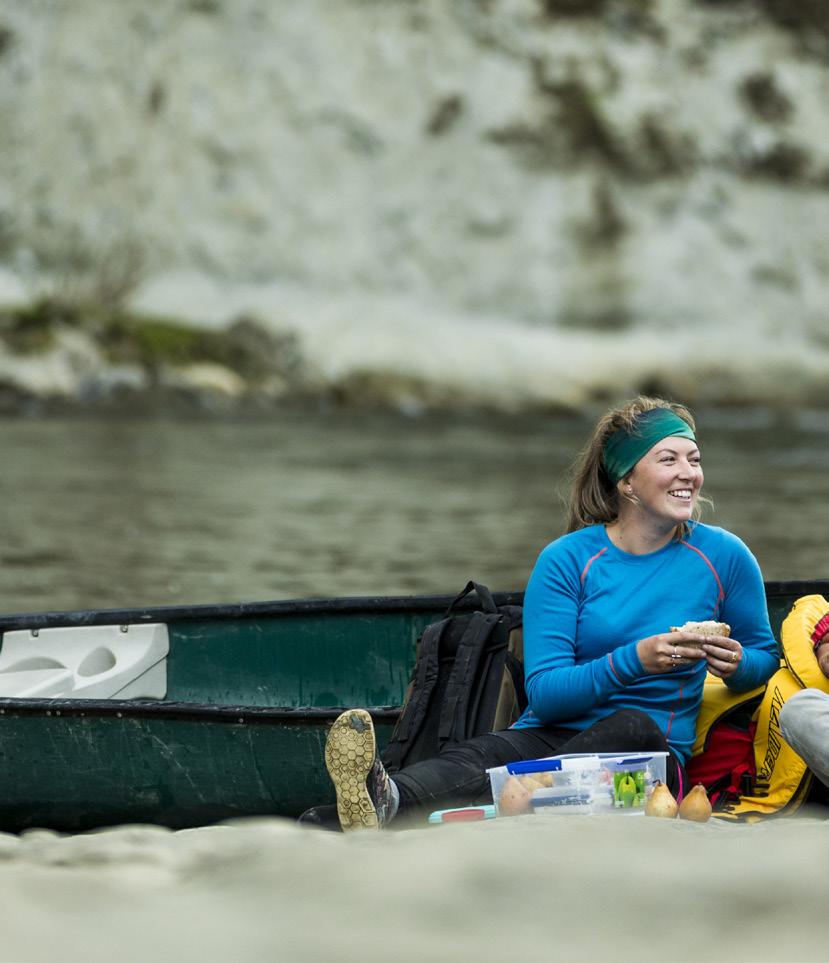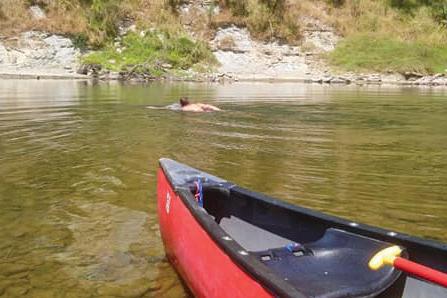
4 minute read
The Whanganui River: a Great Walk with no walking
Our writer, Anna, took her partner for a five-day paddle down Whanganui River. She survived to tell the tale, but did her relationship?...
As we edged the canoe off a bed of pebbles and hopped gingerly into its rocking hull, a man, who was also untying himself from the embankment, and evidently on the same Whanganui River journey as ourselves, casually enquired if we’d fallen out yet.
Advertisement
– quipped my partner.
It is indeed a testament to any relationship, that if you can survive five days on New Zealand’s thirdlongest river, without committing murder, declaring divorce or throwing your paddle in the direction of someone else’s head, your relationship can endure anything.
I did none of the above, but I will admit to hastily abandoning ship when we misjudged a rapid and hit the riverbank; choosing to save myself and, as a result, compromised any remaining stability we had. As my feet touched dry land, my partner was taken downriver, stalked somewhat comically by a rogue canoe. My amusement soon wore off when I realised my predicament: stay stranded or follow suit, if only to get reacquainted with my belongings – and my soggy betrothed.
If you, like me, feel the Eiffel Tower is smeared by gimmicky souvenirs, and find places such as Halong Bay too busy, five days on the Whanganui River will provide that very indulgence we seek, but rarely find: pure, untainted adventure.

Resting near Whanganui River
© Visit Ruapehu
Canoes are hired from companies in surrounding Ruapehu townships, transported to your chosen departure point and then, after a quick safety briefing, that’s it. In typical Kiwi gung-ho fashion, you’re pushed off the embankment and sent on your way. We’ll see you in five days they say, and then it’s just you, a canoe and the great outdoors.

Canoeing by Tamatea’s Cave, Whanganui River
© Visit Ruapehu
First things first: negotiating rapids is a two-person job. Put the lightweight passenger upfront to spot for hidden snags, which at their very worst can wrap canoes into such a tight grip, it takes weeks for them to detach – and spells the immediate end of your trip. In the back, you want the muscle; the brawn that will steer you successfully away from a cliff face, should a tumultuous eddy wish to send you that way.
NB: This is why and when arguments arise, because each rower is inevitably doing a better job than the other, and a not-so-good job at keeping such thoughts to themselves.

Camping out by the Whanganui River
© Anna Sarjeant
For the most part, there are very few turbulent rapids to navigate. The river, enveloped in soaring cliffside, is tucked serenely into a gorge; the water so reflective, it’s hard to believe your paddle doesn’t shatter the surface. Multi-tiered waterfalls pour from heaven, while others trickle in coves you cannot see. Swallows nose-dive before your bow, and goats, as wild as they are numerous, bleat from the shore. When the sun shines and nature sings, there is truly nowhere better to be.
There is, however, somewhere worse you can be, and that’s a DOC long drop. An evil necessity. The acrid stench will attack your nostrils, or if you dare to use your mouth, it’ll burn your oesophagus too. Mercifully, these toilets are joined by some seriously breath-taking campsites. Many are elevated with views stretching miles downriver and come dusk, sunsets to die for. Tieke Kainga is a DOC hut-cum-marae worth aiming for, and if the hosts are on site, you’ll get to partake in a pōwhiri.
Days later, when you reluctantly reach Pipiriki and the end of your adventure, falling in the water becomes the least of your worries. In fact, in the height of summer, languid swims in the river’s cool ripples is an absolute highlight of the excursion; whether you choose to get in or a rapid decides for you. Without doubt, the very worst part of the journey – and definitely the most distressing aspect – is accepting it’s over. And for some couples, that might just mean the relationship too!

Swimming in the Whanganui River
© Anna Sarjeant
Know before you go:
The journey is 3-5 days long and guided tours are also available.
Canoes accommodate two rowers and four barrels for your belongings.
DOC huts are not facilitated. A camping stove was one of the best items we packed.
Canoes are approx $200 each and DOC sites are $20pp per night.
Booking DOC campsites is required between October and April.
Take a break from the water on a short walk to the Bridge to Nowhere.
Campsites are often located at the top of steep embankments and you’re required to carry everything you need there.
More Whanganui River activities:
JET BOATS: Rip up the river at speed.
CRUISE: On-board the Waimarie, a coal-fired paddle steamer.
HIKES: Trek to the Bridge to Nowhere.
MOUNTAIN TO SEA CYCLE TRAIL: Includes jet boating or canoeing on the river.










